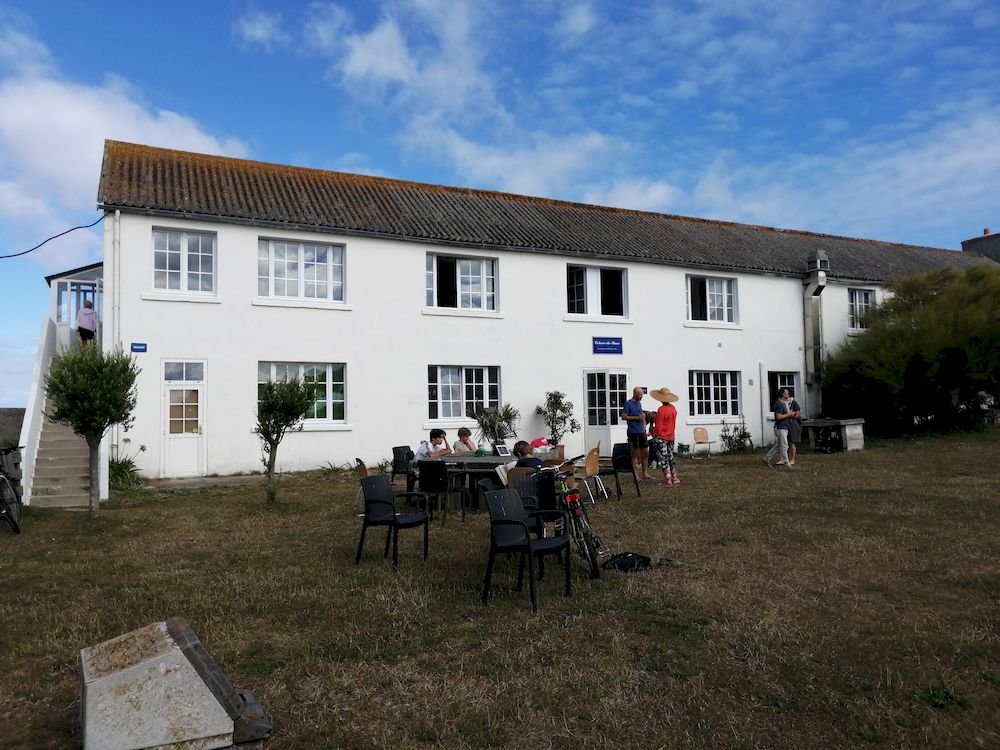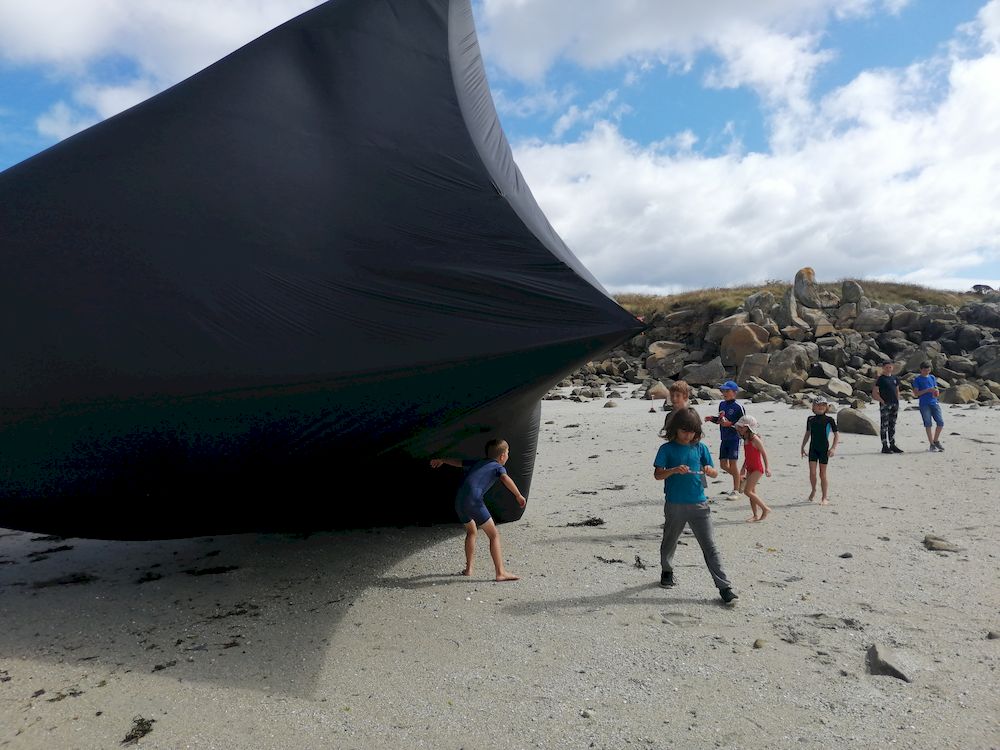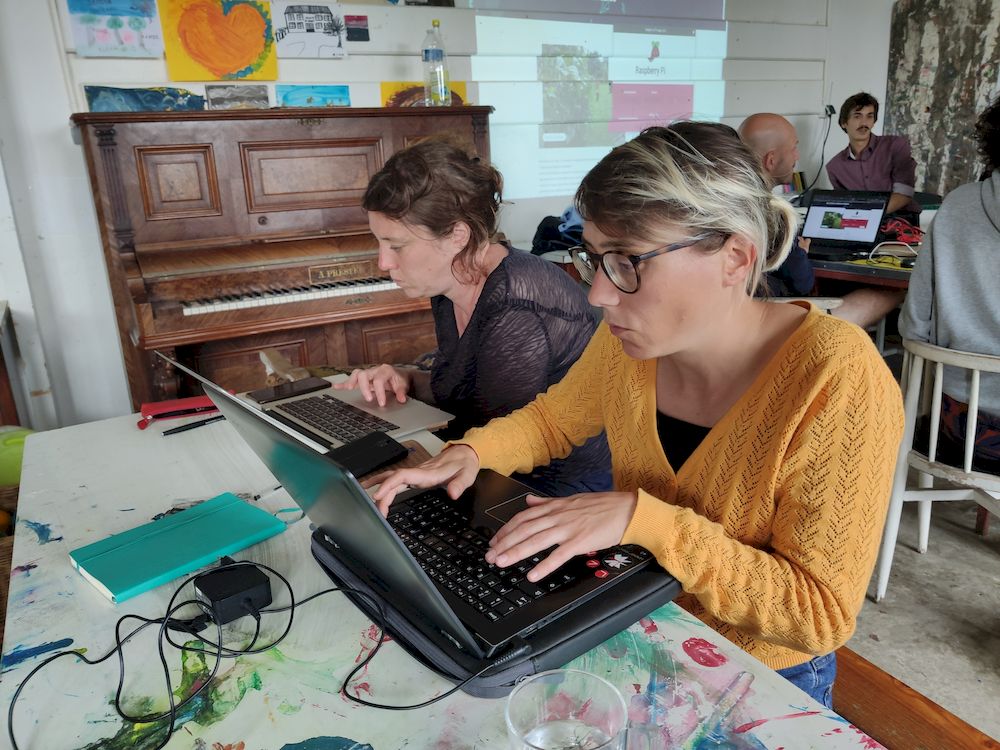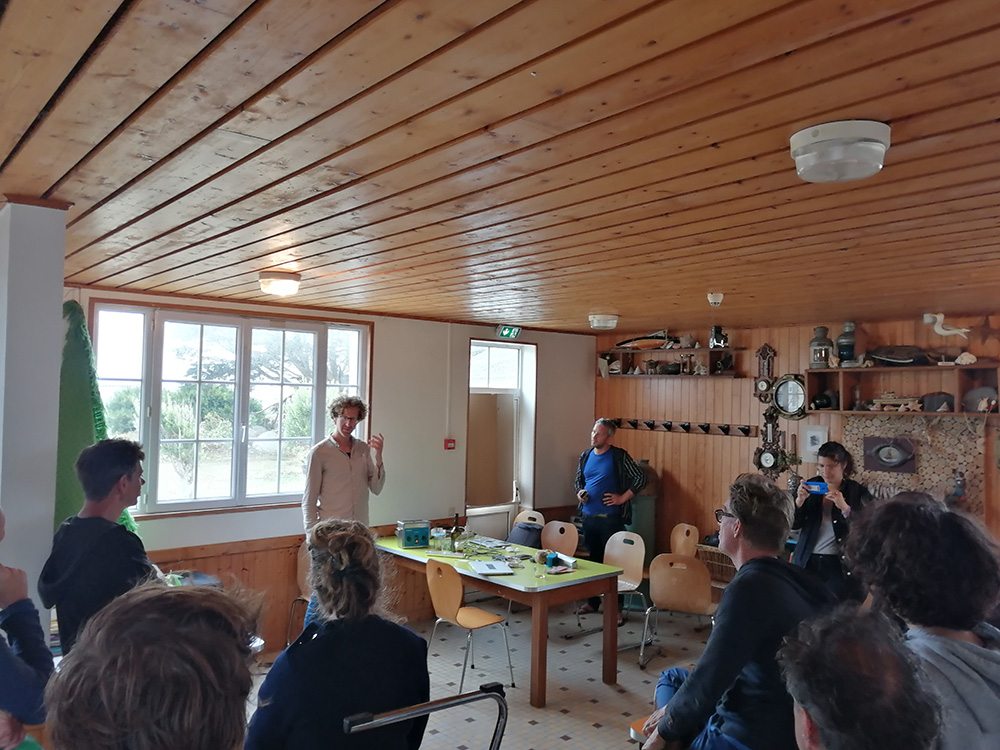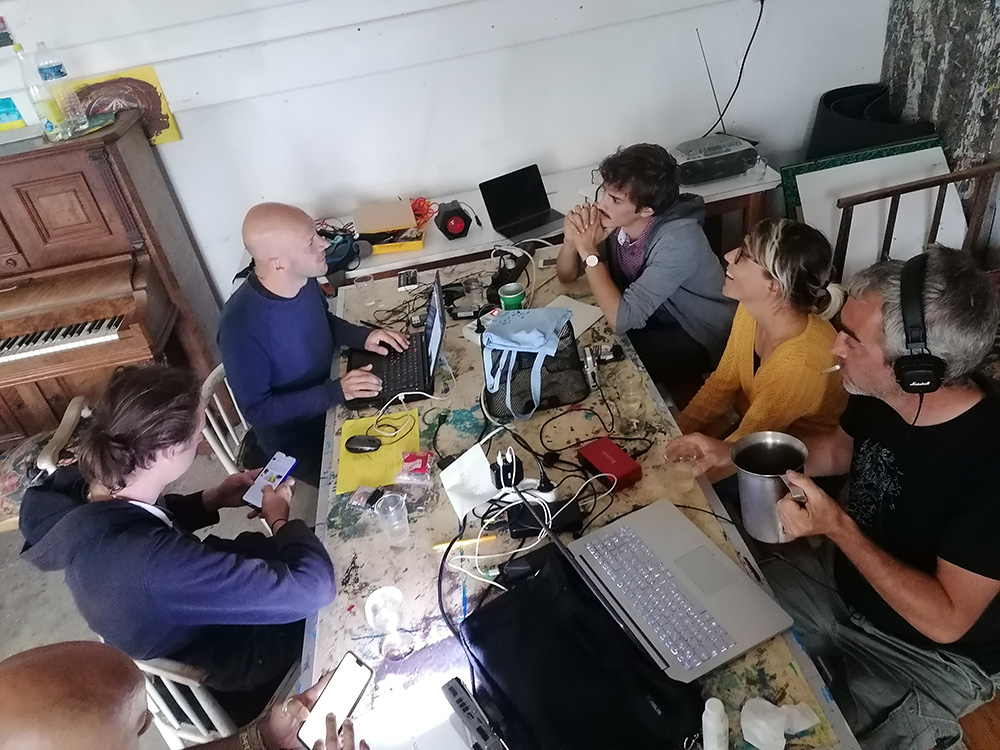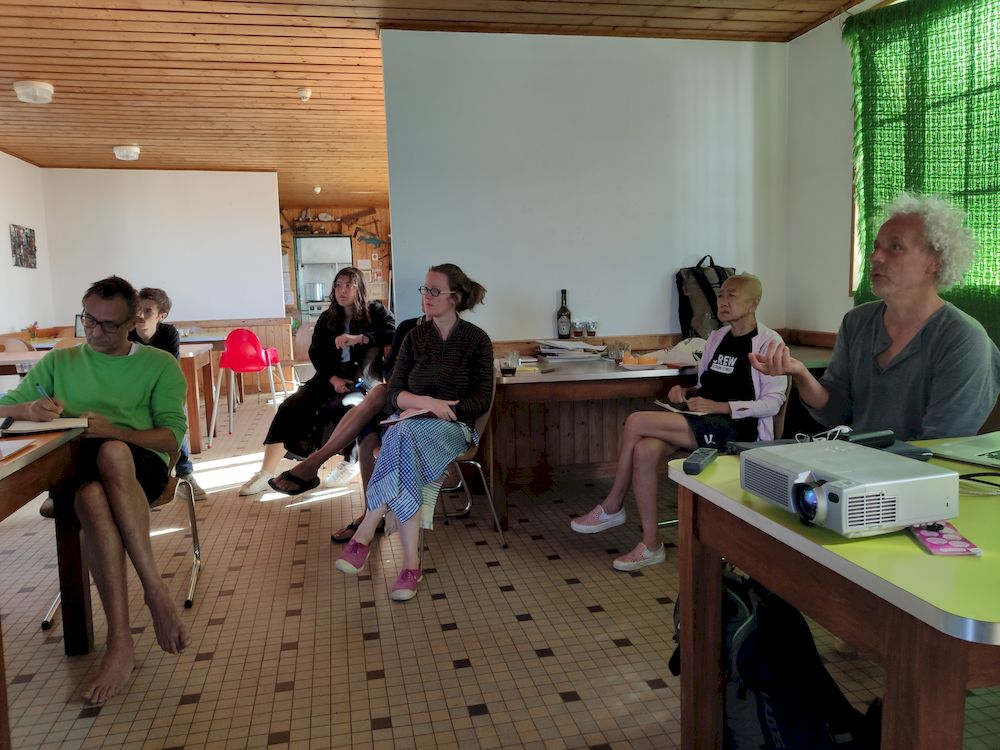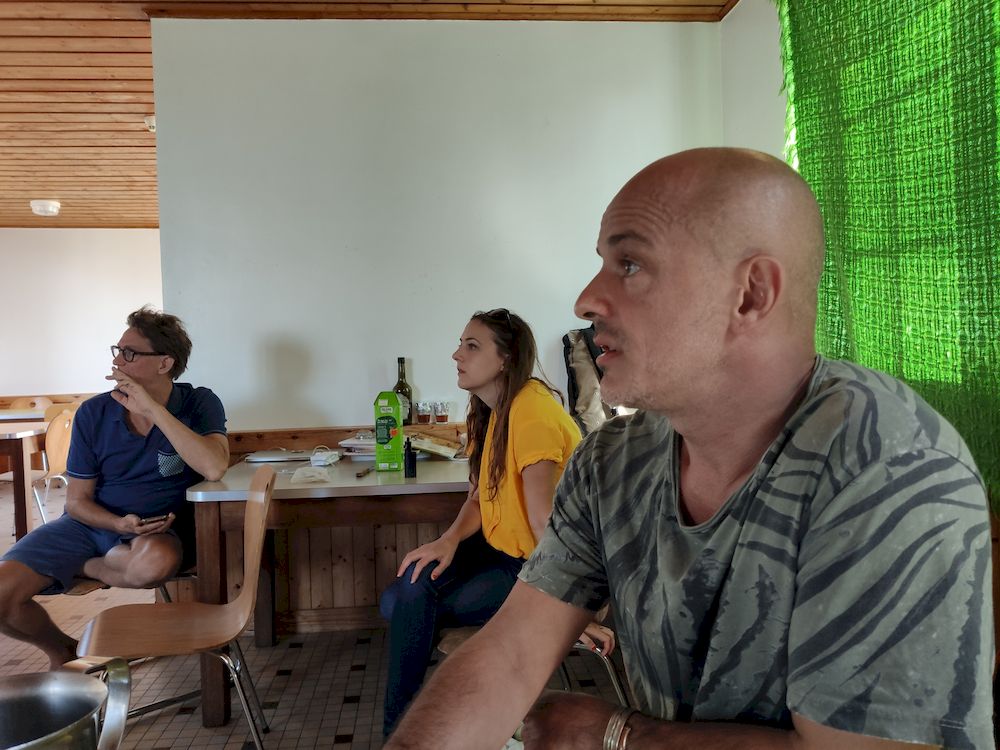ArtLabo retreat 2020
ArtLabo Retreats are part of the Feral Labs Network and co-funded by the European Union – Feral Labs (2019-2021) & Rewilding Cultures (2022-2026)
Living symbiotically on the French Island of Batz
by Roland Fischer
(first published in Makery on September 20, 2020)
From August 16 to 24 2020, the first “ArtLabo Retreat” took place on the Island of Batz in France. The event was an encounter with the ArtLabo network, part of the Feral Labs network series launched in 2019. Roland Fischer from Symbiont.Space in Basel writes about his experience.
The periphery is the new center. And vice versa. Paris was almost empty in mid-August, but I was just passing through. Three hours west of the capital, the train was was practically full. Rain welcomed me in Morlaix, and another half-hour later I was sitting on a cafe terrace in Roscoff, on the northern coast of Brittany. The air was salty, the rain had stopped; the weather is fickle here. Final destination: Batz Island. Tidal range: maximal. Temperature range: minimal.
This geographical exception would be the perfect location for a week of exchanging with folks from all around Europe working on art-science projects—at least that was the plan before the Coronavirus struck us with its particular understanding of symbiosis. It turned out that Brittany was somewhat of a safe haven, as its number of Covid cases was among the lowest in Europe. Many people who had intended to come from abroad decided to stay at home nonetheless, given all the travel restrictions. The French, however, flocked to the island—Brittany’s remote coastline had never seen such a busy holiday season.
Distinguishing themselves from the flurry of tourists who were more interested in hiking and sunbathing, some 20-30 individuals gathered on Batz Island for a weeklong communion of experiments and discussions. As part of its activities within the European Feral Labs Network, Makery organized its first summer camp there: ArtLabo Retreat. Conceived as a meeting between the European Feral Labs network and the French ArtLabo network, the retreat provided an opportunity to share research and creative practices in Art/Society/Technologies.
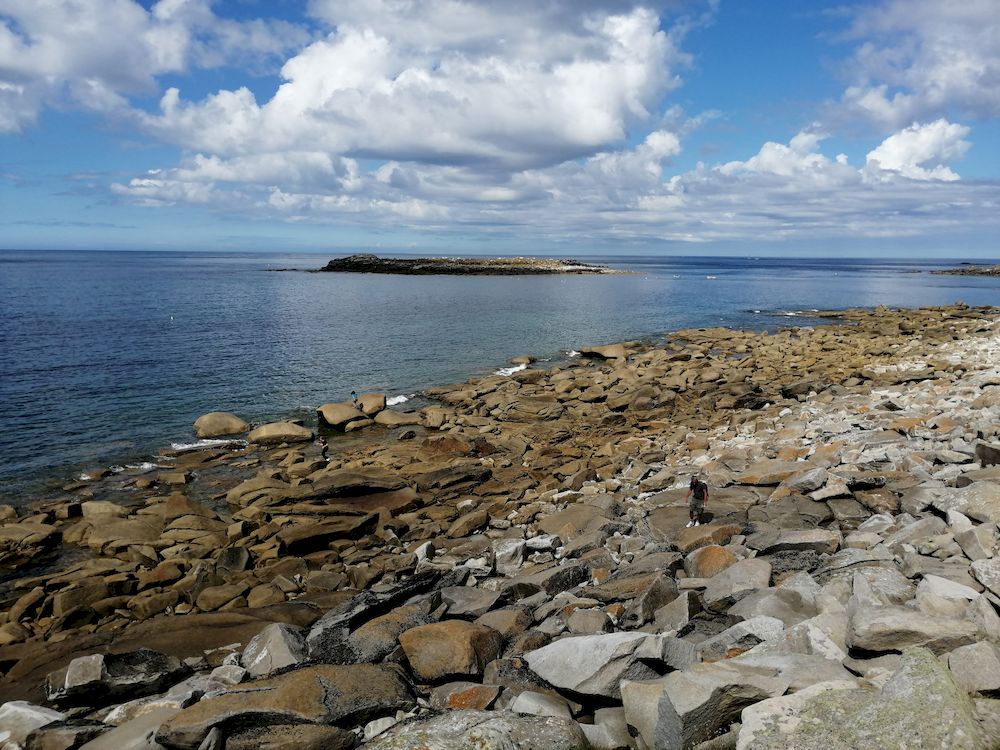
In search of symbiosis
The theme of the retreat was “symbiosis”, in very broad terms: long-term partnerships between organisms, merging different skills or abilities in order to “upgrade” the system as a whole. Of course, this relationship holds true for many art projects as well, especially at the intersection of art, technology and science.
So it was quite fitting to kick off the event with a screening of the documentary film Symbiotic Earth about the evolutionary biologist Lynn Margulis. An eminent figure of modern biology, Margulis was often ridiculed at the beginning of her career. Her audacious idea was that evolution is not a continuous process, sometimes it happens in leaps and bounds. Abilities evolve within independent lifeforms, and something totally new and much more interesting emerges when two of these “prototypes” merge. She called it “symbiogenesis”. Instead of the mechanistic view that life evolved through random genetic mutations and competition, Margulis presented a symbiotic narrative in which bacteria joined together to create the complex cells that formed animals, plants and all other organisms—which together form a multi-dimensional living entity that covers the Earth. This also implies that humans are hardly the pinnacle of life itself, with the right to exploit nature, but simply one part of this complex cognitive system. As Margulis says in the film: “Bacteria have been here for billions of years, long before we arrived. They rule the world.” We could add, with the current headlines in mind, that viruses are certainly part of that old empire too. They might even be the discrete kings of symbiosis, but that’s a different story.
The screening was followed by a discussion led by Xavier Bailly, researcher of the Multicellular Marine Models laboratory of the Roscoff Biological Station and an expert on the local symbiotic hero: Symsagittifera roscoffensis, a marine worm that ingests algae to use them as energy supply—a truly exceptional “animal-plant” of the Brittany coastline. His presentation sparked a debate about symbiosis vs. parasitism. Who is exploiting whom in this merger of animal and algae? Is symbiosis always beneficial for both partners? And surprise—according to Wikipedia, we’ve been wrong about symbiosis all along: Symbiosis (from Greek συμβίωσις, sumbíōsis, “living together”, from σύν, sún, “together”, and βίωσις, bíōsis, “living”) is any type of close and long-term biological interaction between two different biological organisms, be it mutualistic, commensalistic, or parasitic.
So, even parasites can be symbionts? Nature doesn’t seem to insist on consensual relationships. Xavier Bailly showed recent close-ups from his lab exposing the algae in very “unnatural” forms. It looks almost as if they were constantly trying to flee their new habitat inside the worm’s body. So what about the arts? What are the power structures when it comes to art and science collaborations? Who is embracing whom here? Still much too often, these kinds of projects are shaped by hidden hierarchies—just follow the money. Scientists tend to exploit the arts according to their needs: popularization, illustration, creativity (a.k.a “thinking outside of the box”). In these contexts, the metaphors of mutual vs. parasitic can be used to reflect on structural and political framings of artistic collaborations, whereas Margulis herself warned about the dangers of using anthropomorphic concepts when describing or analyzing biological phenomena.
The Roscosmoe project, hosted by Ewen Chardronnet, takes the Symsagittifera roscoffensis story one small step (or one giant leap?) further, into space. The project narrates the journey of S. roscoffensis through the stages of its selection as a “cosmonaut candidate” in view of its possible departure for extraterrestrial space. Should we see the “animal-plant” as the perfect space explorer, living solely on the energy of the sun?
Feral energies
Speaking of solar energy, the Energylab, hosted by Cédric Carles and Loïc Rogard from Atelier21, presented fantastic innovations from the history of energy: pioneering devices that were not considered relevant or reliable in their time, did not find interested users or lacked a technical brick to make the system efficient. As they say: “Inhale the past, Exhale the future, Fly with the sun”. A recent descendant of the solar flight pioneers was present on the island as well. Weather permitting, sometime over the course of the week they had planned to fly the solar balloon Aerocene Backpack from Aerocene Community France, hoping to send a GoPro camera high up in the air. But as mentioned previously, the weather is fickle: after a moment of sun there were too many clouds, so instead of a research device, the balloon ended up being a huge and surreal black toy for the children on the beach. But that worked just as beautifully.
Meanwhile, Joachim Montessuis invited everyone into a think-tank, an ephemeral discussion-debate group about art and consciousness, based on his course on sound and spirituality at Ecole Supérieure des Arts Décoratifs in Strasbourg. Is the artist’s subjective ego (or even collective ego) still a sufficient notion nowadays? Can we go beyond the existentialist binarity of the ego of the artist who is master of his reality and his destiny, in order to gain a deeper experience? Who creates, for whom, and for what benefit? Back to the debate around symbiosis and parasitism.
Channeling a more substantial kind of spirit, I decided to expand my experiments in sonic maturing to local applejack liquors, injecting them with high doses of ultrasonic energy. Is this physical chemistry or succussion quackery, as practiced by homeopaths? What happens to strong alcohols when they are stimulated with ultrasonic waves? When they are basically shaken very hard, from the inside out? There is a tradition: “The color and flavor of Kentucky bourbon came from the rocking on the water. Bourbon was loaded on to ships in Kentucky, and by the time it traveled to the people buying it, the flavor improved.”
The Margulis documentary found a surprising echo two days later in Spaceship Earth, a film about the most unlikely partnership of late capitalism: Biosphere 2 and Steve Bannon. Pity both films were terribly conventional, artistically speaking: first-person narrations, talking heads. In contrast, some of the presented projects offered somewhat different and more rhizomic experiments in cultural-technological practices.om the rocking on the water. Bourbon was loaded on to ships in Kentucky, and by the time it traveled to the people buying it, the flavor improved.”
Radio Batz
A few members of MyOwnDocumenta (Corisande Bonnin, Charlotte Imbault, Dominique Petitgand) also joined the retreat. MyOwnDocumenta (artists publishing works-in-progress and diaries hosted by David Guez) is a group that believes that the process is probably more important than the final result, which was certainly the case in discussions of the ArtLabo network led by Julien Bellanger and Catherine Lenoble. Their workshop was held all week long in the studio of the colony, a beautifully strange space full of toys, painting accessories, holiday leftovers. There the hosts invited all participants to discuss and test tools and practices related to documenting and sharing our experiences towards more digital autonomy. Along the way, the colony became an ephemeral radio station, broadcasting on Pi-node. It sent out signals in the dark, just like the lighthouse on the hill above the colony, as its beam continued to rotate, blinking out its message to the black seas. But wait, is there a signal even when there is no one to see it?
The event
Since 2015, Makery has been a member of the network ArtLabo. The ArtLabo Retreat 2020 is a meeting between the European network Feral Labs and the French network ArtLabo, two networks sharing research-creation practices Art/Society/Technologies.
Due to Covid-19, the ArtLabo Retreat has however had to reduce its staff and give up a call for projects.
Feral Labs network
A network of temporary and offshore hubs for research in art, technology and communities, the Feral Labs Network, is composed of six partners from six EU countries, who have come together in their common interest in arts and science research and contemporary Do-It-Yourself (DIY) and Do-It-With-Others (DIWO) communities. Rather than focusing on modes of presentation such as exhibitions and festivals, the Feral Labs network focuses on connecting and organizing a series of similarly formatted temporary creative camps and environments, with an emphasis on process-based activities such as peer learning, fieldwork, research and co-creation. What these activities have in common is their deliberate placement in a remote environment, far from the usual urban setting of contemporary creative centers.
Over the past two years, the project partners have been creating a variety of temporary creative poles that vary in scope, format and topics covered, but all have a common methodological starting point: temporary, international, remote, open and transdisciplinary (art-technology-science).
The Feral Labs network is initiated and coordinated by the Projekt Atol Institute (SI) in partnership with Makery/Digital Art International (FR), Catch/Helsingør Kommune (DK), SCHMIEDE HALLEIN – Verein zur Förderung der digitalen Kultur (AT), Bioart Society (FI) and Udruga za razvoj uradi sam kulture Radiona (HR).
Network ArtLabo
Since its informal creation around 2004, ArtLabo is animated by structures such as the Labomedia (Orléans), PIB (Tours), the Lieu multiple (Poitiers), Bandits-Mages (Bourges) and the association PiNG (Nantes) but above all many people involved in common research-action territories. ArtLabo has been organizing meetings for many years, 0camp in Nantes in 2015, 1camp in 2016, or during the Human Tech Days / Rencontres Arts & Sciences Friction in Bourges in January 2020. The principle: based on a common axis of work, the partner structures, as well as a large network of speakers, test during a given period the collective exploration of a subject around a program, debates or a coordinated series of common actions.
Workshops
ArtLabo
Hosted by Julien Bellanger and Catherine Lenoble
Behind the philosophy of collaborative projects and informal exchanges, the ArtLabo Retreat 2020 workshop will be an opportunity to discuss and test tools and practices related to documenting and recounting our experiences towards more digital autonomy (Radio, pad writing with CodimD, system autonomous or not, etc.).
Roscosmoe
Hosted by Ewen Chardronnet
The objective of the Roscosmoe project is to narrate the journey of the Symsagittifera roscoffensis, a symbiotic marine worm, an exceptional “animal-plant” of the Breton coastline, in the stages of its selection as a “cosmonaut candidate” in view of its possible departure for extraterrestrial space. Roscosmoe is a speculative narrative exploring the endosymbiotic theory of evolution (Lynn Margulis), our multi-species nature, the fragility of marine symbioses and environments in the face of global warming, ocean acidification and anthropogenic influences, notions of spatial ecology and the study of living things and the evolution of life in the face of conditions of variable gravity. The Roscosmoe project aims to create an artistic installation that will take the form of a connected and self-sufficient bathyscaphe aquarium containing a colony of marine worms in seawater. This speculative prototype of a future research module for a space station will be surrounded by multimedia devices offering the vital and environmental data of the device in real time, a system of multicasting of the different stages of the selection of the “candidate-cosmonaut”. The objective of the workshop on the Island of Batz is to become familiar with the species Symsagittifera roscoffensis and to determine the scriptwriting processes of the speculative narrative around the Roscosmoe project.
Symbiotic Earth
Animated by Xavier Bailly and Ewen Chardronnet
Viewing of the documentary Symbiotic Earth on evolutionary biologist Lynn Margulis on two mornings on Tuesday 18 and Wednesday 19 August, followed by a discussion around the film on the 19th conducted by Xavier Bailly, researcher of the laboratory Multicellular Marine Models of the Roscoff Biological Station.
SYMBIOTIC EARTH explores the life and ideas of Lynn Margulis, a brilliant and radical scientist, whose unconventional theories challenged the male-dominated scientific community and are today fundamentally changing how we look at our selves, evolution, and the environment.
As a young scientist in the 1960s, Margulis was ridiculed when she first proposed that symbiosis was a key driver of evolution, but she persisted. Instead of the mechanistic view that life evolved through random genetic mutations and competition, she presented a symbiotic narrative in which bacteria joined together to create the complex cells that formed animals, plants and all other organisms – which together form a multi-dimensional living entity that covers the Earth. Humans are not the pinnacle of life with the right to exploit nature, but part of this complex cognitive system in which each of our actions has repercussions.
Filmmaker John Feldman traveled globally to meet Margulis’ cutting-edge colleagues and continually asked: What happens when the truth changes? SYMBIOTIC EARTH examines the worldview that has led to climate change and extreme capitalism and offers a new approach to understanding life that encourages a sustainable and symbiotic lifestyle.
ATELIER21 ENERGYLAB: “Inhale the past, Exhale the future, Fly with the sun”
Animated by Cédric Carles and Loïc Rogard
The history of energy is full of fantastic innovations, precursor devices that were not considered relevant or reliable in their time, did not find interested users or lacked a technical brick to make the system efficient. Yet these forgotten inventions are today in a position to respond favourably and probably unexpectedly to the challenges of the world to come. This new writing of the history of energy calls for an overall vision that allows us to move on to other fertile phases of analysis and creation. The methodology of the platform paleo-energetique.org therefore proposes to explore the public domain, retrotech and lowtech in order to unearth unjustly forgotten innovations. “Inhale the past, Exhale the future”: the Arte Labo Retreat will be the occasion of a retrospective around the foundation Aerocene, to gather a collective iconography and to reconstruct a history of flights and machines to fly, each one crazier than the other, including those using bicycles or solar energy. “Fly with the sun”, depending on the weather, we will be able to organize flights with the solar balloon Aerocene Backpack from Aerocene Community France, it will be possible to take pictures with go pro, to test the maximum weight that can be lifted by the balloon, etc.).
The website of Atelier21.
Experiments with sonic maturation: treating drinks with high doses of ultrasonic energy.
Hosted by Roland Fischer
Is it physical chemistry or is it succussion quackery? What happens to strong alcohols when they are stimulated with ultrasonic waves? When they are basically shaken very hard, from the inside out?
“The color and flavor of Kentucky bourbon came from the rocking on the water. Bourbon was loaded on to ships in Kentucky, and by the time it traveled to the people buying it, the flavor improved.”
THINK TANK, ephemeral discussion-debate group around :
Art and consciousness (non-duality and non-binary thoughts)
Hosted by Joachim Montessuis
From the Vedas (knowledge) to the Latin Scientia (knowledge), up to Artificial Intelligence through quantum, we are led to experiment our relationship to reality either with a classic dualistic and objective approach, or with a more subtle, very old and very current approach: the non-distinction between consciousness and matter. This approach completely redefines our relationship to reality, to the social, political and therefore artistic space. But what are really the differences between dualism and non-dualism?
Is the artist’s subjective ego (or even collective ego) still a sufficient notion nowadays? Can we go beyond the existentialist binarity of the ego of the artist who is master of his reality and his destiny, in order to have a deeper experience? Who creates, for whom, and to what benefit? Is non-dual awakening the last vanguard in a mutant world?
The participants and residents of the ArtLabo Retreat:
Xavier Bailly (Laboratoire M3, Station Biologique de Roscoff, Fr)
Charlotte Bartissol (Atelier21, Fr)
Julien Bellanger (Ping, Fr)
Corisande Bonnin (Fr)
Cédric Carles (Atelier21, Fr)
Ewen Chardronnet (Makery, Fr)
Shu Lea Cheang (Tw/US/Fr)
Florence Cherrier (ArtLab – Mains d’œuvres & La Station, Fr)
Julie Corre (Fr)
Eric Daviron (Collectif Mu & La Station, Fr)
Roland Fischer (Symbiont.space, Ch)
Clément Gasque (GDP, Fr)
David Guez (MyOwnDocumenta, fr)
Agathe Herry (Fr)
Charlotte Imbault (Fr)
Wolf Kuehr (Volumes, De/Fr)
Olivier Le Gal (Collectif Mu & La Station, Fr)
Catherine Lenoble (PIB, Fr)
Alice Marsal (Fr)
Anne Métrard (Fr)
Joachim Montessuis (Fr)
Florence Morat (Fr)
Olivier Morvan (Fr)
Dominique Petigand (Fr)
François Robin (Makery, Fr)
Loïc Rogard (Atelier21, Fr)
Gaël Segalen (Fr)
Lionel Sayag (Fr)
Marc Swyngedauw (Fr)
Anaïs Tondeur (Watermarks, Fr)
Miha Turšič (Waag, Si/Nl)
SUPPORTED BY





